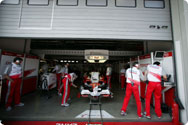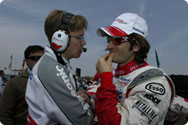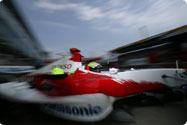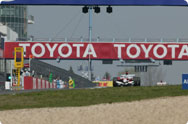Thank you, as always, for your support. Here is the report from the fifth race of the season, the Grand Prix of Europe.
Wanting to show our best at the Nurburgring, our “home away from home”
The Nurburgring, site of the Grand Prix of Europe, is very close to the TMG headquarters in Cologne. Just as with the German Grand Prix (Hockenheim) and the Grand Prix of Japan (Suzuka), we feel strongly that the Nurburgring is a “home” race for us. Ferrari made an impressive showing at their home course in Imola, and I would be very happy if we could show that kind of power here in Germany.
 |
 |
| The chassis remained nearly unchanged, based on the team’s decision to use the “best combination.” The engine was also largely unmodified, but the increase in maximum RPM was noticeable. |
|
The cars are exactly the same as they were in the prior race at Imola. We think that the current combination is the best for what we are running. Jarno (Trulli) will be on a fresh engine, while Ralf’s (Schumacher) will be on its second race. While I personally feel that this set of engines is amazing, I will hold off on commenting for now. But if you had a chance to listen to the sound of these engine, you'd notice that each iteration makes a higher sound (=higher RPMs).
After the Imola race, we went to Paul Ricard to conduct tests on our B spec, which we will be putting into action in the seventh race of the season at Monaco. The big change for this car is in the front. The TF105B featured significant changes to the front of the car, while the TF106 featured changes to the rear. With this next chassis, we will be introducing a model change once again for the front. Our drivers have reported that the B spec car demonstrates improved front performance, so I think we have been able to achieve our objective.
Concerned by sudden unexplained vibration trouble
The weather was fine, but team felt like it was being pummeled with alternating downpours and clearing skies. Actually, when we went out for the morning practice, Jarno and Ralf both complained about vibration in their cars. Ralf continued to turn in laps when we were able to reduce some vibration after asking Bridgestone to rebalance the tires.
With Jarno, our original plan was to only do an installation drive (verify car functions), so we had Bridgestone rebalance Jarno’s tires and left it at that.
| |
 |
 |
Jarno Trulli was prevented from recording a time during Friday’s free practice due to vibration issues. The team decided to resolve the problem using the spare car, and Jarno captured the highest qualifying position of the year at P7, fully expecting a top finish together with Ralf. |
 |
However, once we started the afternoon practice session, Jarno reported that the vibration in his car was worse than ever. At that point, we replaced all of the rotating parts we could, including the brakes, tires and steering wheel, and then had Jarno repeat the installation drive from the morning. Despite our work, we were still not able to resolve the vibration issue. Vibration problems are not uncommon, but generally they clear up once you find the right balance for the rotating parts. It just wasn't working out that way in this case.
Being our “home” course, we had many TMG staff in attendance at the circuit. And since the company (TMG) headquarters was nearby, we were in a position where we could issue orders for parts, and make requests for analysis and research into different areas. We finished the day confident that we would be able to make the right preparations for Saturday’s P3 (Practice Session 3) and qualifying.
Vibration issues resolved before qualifying. A pledge to race tenaciously.
Honestly speaking, we expected better qualifying results than P7 and P11. We would have been all smiles if we could have captured the pole, but it didn't work out that way.
We couldn't analyze Jarno’s vibration problems at the circuit, so we sent the parts to TMG. They looked into various potential causes, but we were never able to come to a conclusion. In the meantime, some of the team suggested that the monocoque itself could be the cause of the problem, so we moved the engine and transmission into the T car (spare car), which ran fine. We were very busy in the morning making up for setup work that we couldn't finish the day before, but I think we were able to make all of the necessary preparations at that point.
 |
 |
| Ralf Schumacher approached his 150th F1 Grand Prix race at the Nurburgring Circuit, located close to his German hometown. Having recorded the third-best time during the third free practice session, Ralf expected strong results in the race, but was sadly forced to retire minutes before the finish. |
|
During Ralf’s time attack in Q2 (second qualifying session) his car spun coming out of Turn 4. He recovered and started another attack run, but this time the brakes locked in the first corner, causing lost time, and resulting in a P11 qualifying. Ralf himself was extremely disappointed with the results.
With smooth progress on Friday, and great times during the morning practice before qualifying, I'm sure Ralf had expected a very strong qualifying result, as did the rest of the team, but so far this year we have yet to see both cars turn in strong performances at the same time. Under these circumstances, I think the drivers become impatient, pushing too hard. I hope that we can put together a package soon that will allow the drivers to drive more comfortably.
With qualifying positions such as they were, we approached the race determined to work tenaciously to improve our position as much as we could by the end of the race. The TMG cheering section was seated in the final corner, and we wanted to do our best to show them a strong finish.
Disappearing prospects for two cars in the points.but some promising results
While we went with a shorter first stint at the prior race in Imola, our selected strategy for this race was to stretch out the first stint. Considering the development of the race, we projected both of our cars had a chance to be in the points, which was what guided our decision.
Slightly off the pace at the start, Ralf ran into a dangerous situation in the first corner, but was able to make his way through cleanly. Jarno immediately gained one position, and was driving very well until his car developed a severe balance problem. The changes we made at each pit stop appeared to have the right effect, and the balance was much better during the final stint. Unfortunately, the conditions still prevented Jarno from increasing his pace, and he ultimately finished barely out of the points in 9th.
| |
 |
 |
Trulli jumped to P6 immediately after the start of the race, but fell off the pace when the team couldn't find the perfect balance for his car. Jarno’s best lap was 1:33:953, about 0.3 seconds off of Ralf’s best time. |
 |
For quite a while, Ralf was held back by traffic in front of him, but we saw that he was poised to finish in the points. Just as he was about to finish well into the points, his engine blew up without any warning. It was really quite sad and frustrating. With the race in Ralf’s home country, Ralf was the center of much attention, and the fact that team home is also in Germany made us all want to make an impressive showing to answer the high expectations. I can only apologize for the way the race turned out.
Jarno did qualify in the top ten with quite a lot of fuel on board, and all indications are that Ralf will be able to increase his pace a bit more. So in that sense, I think we have been able to draw out some positive effects from our experience. The Spanish Grand Prix is this upcoming week, and I believe I speak for the team when I say we want to do everything in our power to be ready.
Please cheer us on at the Spanish Grand Prix next week.
|